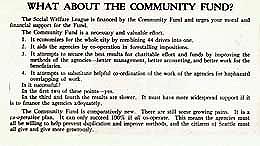This People's History is based on the early records of Wellspring Family Services, a private, non-profit organization helping families and children in Seattle and King County overcome life's challenges. Founded in 1892 as the Bureau of Associated Charities, Wellspring Family Services has operated under a succession of names. At the time of the events described in this essay, it was called the Social Welfare League. This essay discusses a brochure panel from the late 1920s about the Community Fund, the forerunner of today's United Way of King County, of which the Social Welfare League was a founding member. Wellspring's services have changed over the years, but have always centered on a commitment to a stronger, healthier community. These archival records offer glimpses into aspects of Seattle history not well documented elsewhere, examining societal attitudes toward poverty, need, illness, and addiction -- all of which have altered considerably since Wellspring's early days. This is one of a series entitled "Out of the Archives," and appeared in January 2012 in Wellspring's monthly internal newsletter, The Fiddlehead. It was written by Wellspring Family Services executive assistant Deborah Townsend.
What About the Community Fund?
Here we look at the last panel of a 1927 or 1928 brochure from the Social Welfare League, as our agency was then called. The panel title is "What About the Community Fund?" The Community Fund was the forerunner of today's United Way of King County and was established in 1921 with the Social Welfare League as a founding member.
This panel is puzzling. First, it's odd to give this much page space to another agency, even one we were part of. Second, the focus is on structure, not on service, which does not match the rest of the brochure. Also, the last paragraph sounds pretty defensive.
We don't know all the circumstances behind the statements in this panel, but we do know some history. In 1913 the business and philanthropic communities in Cleveland, Ohio, set up the first "Community Chest" as an independent organization to support a number of local causes through unified fundraising. This concept was soon recognized as a best practice and spread rapidly.
As far back as 1915, our own agency was researching the concept and advocating strongly for a similar organization in Seattle. After the Community Fund of Seattle took shape in 1921, several Social Welfare League board members served on the Fund's board. Despite the history of involvement and close connections, though, we see that the Community Fund, although a great idea, got off to a bumpy start here. Our agency archives show us just the one side of the story, of course. Still, what we can piece together shows some tensions.
Loyal but Frustrated
Although our annual report for 1921-1922 stalwartly declares, "The Social Welfare League is a loyal member of the Community Fund," our board minutes of that year describe mounting frustration, mostly about money. The Community Fund’s combined drive in 1922 was disappointing, and all member agencies had to take a 25 percent funding cut. In the following years, the Social Welfare League submitted proposed budgets and received 60 to 75 percent of its requests. Then there were disputes about permission for the Social Welfare League to do any separate fundraising, even among people who had not donated to the Fund. There were additional disputes about whether we could circulate our own publicity and over our board's suggestion that the Community Fund hire an executive director who understood social work.
The summer of 1925 was a low point. Struggling to live within a much-reduced Community Fund budget -- the Social Welfare League had requested $125,000; the Fund had allocated only $80,000 -- the Social Welfare League board actually passed a resolution to direct clients we couldn't afford to serve to go to the Community Fund office instead.
The Fund's restrictions on "outside fundraising" were apparently relaxed in 1926, which helped, and the Social Welfare League worked to build up other sources of financial support. The relationship between the Social Welfare League and the Community Fund remained strained. In just one example, The Seattle Times 1927 Christmas Appeal (forerunner of the current Fund for the Needy) contributed to the Social Welfare League, and the Community Fund proposed to subtract that amount from the Social Welfare League allocation. Our board minutes continued to reflect frustration, and some remarkably outspoken criticism, for several more years.
Remember, we are looking only at our own materials. The Community Fund archives might tell a different story. Still, with this background, it's no wonder that this panel of the Social Welfare League brochure from 1927 or 1928 is somewhat puzzling.

